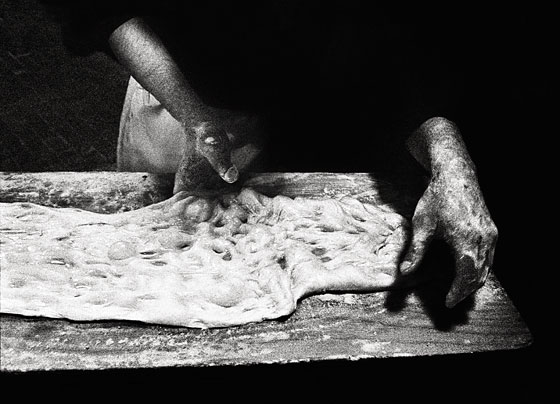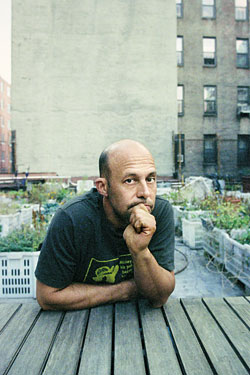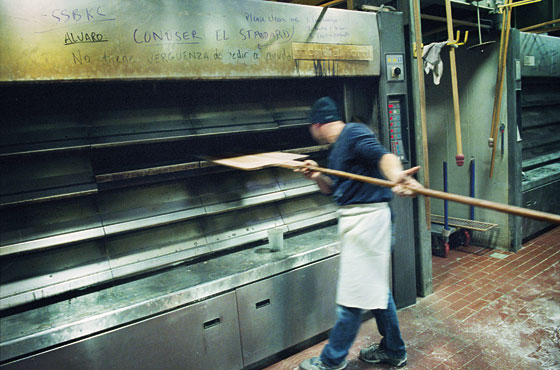
Jim Lahey is having a teaching moment. His classroom is the flour-hazed kitchen of his Hell’s Kitchen–situated Sullivan St Bakery. His students this morning are Alvaro and Dumbia, two employees whose dismaying pizza bianca alla Romana technique has agitated the master. Seeing that the six-foot-long flatbread they just slid into the oven contained invisible-to-the-lay-eye “thumb divots,” the 45-year-old scourge of bread “mediocrity” decides to show how it’s done.
Lahey, who looks like Bruce Willis might if he went on a zero-carb diet and started wearing Crocs, has taken to studying the movie Master and Commander for its leadership lessons, which seem to boil down to a 21st-century landlubber version: Meet my high standard or walk the plank. Working quickly and fluidly, he stretches out another six-footer, carefully using the flats of his palms. Then he “docks” the bread, dimpling it with a shallow-tissue finger massage that will keep it from inflating like pita. “What’s nice about bread at its best,” Lahey says, “is it expresses craftsmanship.”
Ten minutes later, the apprentice bakers’ pizza bianca comes out of the oven, charred and lunar and exuding deliciousness. Unless you are Lahey. “These big bubbles—that’s what we do not want. We do not want this. This is a defect.” He gestures clinically at an errant fraction of the bread where it has puffed up a little. “If I had to rate this, on a scale of one to ten? Five. Passable. Commercial. But not the highest standard.”
Alvaro and Dumbia smile sheepishly. A few minutes later, arguably the best bread baker in New York City peels his own bianca out of the oven. A slight improvement, but part of it he finds “too flat.” Lahey rates his own creation a 5.5.
Amid New York’s current bread renaissance, with its upstart microbakeries like Bien Cuit and La Boulangerie, no one’s flour-dusted fingerprints are as evident as those of Jim Lahey. As the man behind both artisanal-Italianate Sullivan St Bakery and beloved charred-crust-specialist Co. pizzeria, Lahey has been at the forefront of both the nineties New York quality bread-quake and the more recent tomato-pie wars. Lahey is the rare dough-slinging craftsman known beyond his industry. He belongs to the tiny club of restaurateurs who have dared publicly criticize their reviews by the Times. (He unhumbly suggested that perhaps Frank Bruni would prefer the pizza at Ray’s.) His stunningly easy “no-knead” bread recipe, publicized as “revolutionary” by Mark Bittman in 2006, made Lahey into a kind of DIY folk hero. But it’s his own bread, served everywhere from Jean Georges to Gramercy Tavern to the Breslin, that set the bar for the new generation. The renowned food writer Corby Kummer has called Sullivan St his favorite New York City bakery, and earlier this year Bon Appétit named it one of the ten best in the U.S.
Lahey seems to have been born with a grenade pin in his mouth. After being kicked out of art school by a dean he says threatened to defenestrate him—“I said, ‘If you lay a finger on me, I will rip your balls out through your fucking eye sockets and I will shit in your mouth’ ”—Lahey made several trips to Italy, including nine months in the Tuscan countryside, learning to love bread. In San Gimignano, he soaked leaves in water, releasing their light coating of wild yeast and using the resulting solution to make the starter that has generated his bread for the past eighteen years. (Proud-parent style, he pulls out his iPhone and shows off a picture of his yeast, a microscopic tableau of cellular balloons and rods he was recently e-mailed by a Harvard genetics professor he had been hooked up with by author-gastroethicist Michael Pollan.)
Back in New York and scraping by in Williamsburg—one year, by his count, he held 37 different jobs—he largely taught himself to bake, and in 1994, with backing from the restaurateur Joe Allen, he opened Sullivan St Bakery in Soho. His bread was a mahogany revelation. Caramelized to the verge of burnt, it was intensely crusty on the outside and pillowy on the inside. The Lahey style, and the shapes and terms through which he expressed it (Pugliese, filone, stirato), is now ubiquitous. It wasn’t just that Lahey’s bread was as fine as any you might find in Rome. Part of the pleasure of his baking was its sense of playfulness, his imaginative riff on Italian tradition: One of his latest innovations is the canotto, or “dinghy”—an addictive little boat of salty-sweet dough filled with, for example, mascarpone, Gruyère, and prosciutto. His wholesale customers came to include Dean & DeLuca and Gourmet Garage. By 2000, he had expanded from the original shop to a larger space in Hell’s Kitchen, and by around 2004 annual revenue had risen to $4.5 million.

But drama ensued. There was a split from his business partner (and former girlfriend), who held on to the original location and renamed it Grandaisy. One of Lahey’s main distributors opened a rival bakery in the Bronx called Il Forno. Both Grandaisy and Il Forno sold product lines indistinguishable from Lahey’s, and Il Forno undercut him on price; he soon saw swathes of his wholesale business cannibalized. “Shameless things were said to get business,” he says with uncharacteristic diplomacy. More of “my imitators” followed. To fight back, he says he engaged in a kind of strategic malingering for three years, deliberately lowering the standard of his bread to appear weaker and throw his adversaries off their game. (He got the idea from Star Trek.) In recent years, Sullivan St–style loaves have become so common that it’s easy to imagine they are imitations of Italian bread rather than Lahey’s idiosyncratic interpretation of it. Lahey professes to be unconflicted about the Lahey-ization of New York bread. “Back then, I was really offended,” he says of one of the more blatant knocker-offers. “Now I’m flattered. Now it’s, ‘Let’s make our bread even better, let’s make sure we give them something difficult to imitate.’ ”
Lahey heads upstairs to his office to meet with a consultant who’s advising Lahey in his attempt to get the bakery LEED-certified. Sullivan St is in transition. Over the past three years, Lahey has shrunk his business by 30 percent, eliminating deadbeat wholesale customers and subpar workers. At the same time, his company is on the verge of expansion. In January, he will open a second Sullivan St Bakery, on Ninth Avenue two doors down the block from his pizzeria Co. Also in the next few months, he will begin renovating the main bakery here on 47th Street. The tiny space for customers will expand to accommodate around 50 seats and serve beer and wine. This office will become what Lahey calls the University of Bread, where he will teach classes in baking and more specialized subjects (microbiology, wheat science). It’s all part of his campaign to undo what he sees as the “bigger is better” culture, first at his own company and then in the industry as a whole.
Those who remember when bread in America came down to a choice between Wonder bread and, if you were lucky enough to live near an old-world-style bakery, maybe a workmanlike baguette could be forgiven for thinking we are living in a bread Belle Époque. Lahey sees only a dark age, a “prevailing culture” of Hot & Crusty and Panera, where corporate chains have appropriated the term artisan. Where the baker has no respect. “I think it’s just above working in a car wash, that’s how glamorous it is,” Lahey says. “Even though it’s the mother and father of all culinary ritual, it’s viewed as the bastard child.” He is frustrated by four-star chefs who serve no-star bread. “Even Eric Ripert and Daniel Humm, I hate to say it, they buy the most horrific bread in the world. I tell them, either hire me or poach someone who works for me.” He is fed up with disrespectful customers. “I don’t want to say anything negative about any of my customers, but I’ve got some amazing customers that are behaving so inappropriately, not paying their bills. A great example would be a certain historic Upper West Side gourmet marketplace.”
Partly because he’s fundamentally an artist and partly because he is a competitive businessman, Lahey has continued to evolve what he does. Once everyone else started making Sullivan St–style bread, Lahey began using his no-knead method, which for a time was his method for making all his bread (and which, as a collateral benefit, released home bread-makers across America from the tyranny of the bread machine). Now he has shifted his emphasis away from no-knead and toward using all-natural fermentation. Lahey was drawn to this method because it dates to bread’s preindustrial age and because, he says, “it makes proteins easier for our bodies to digest.” (To address his own wheat sensitivity, among other ailments, Lahey recently infected himself with hookworm, placing mail-order larvae on his skin under a bandage and waiting for them to burrow into his body and modify his immune system. “Twelve weeks from now, if everything goes well, they’ll be in my lungs and I’ll have a bad cough, but instead of spitting out the worms, I have to swallow them.”)
Lahey is a perfectionist but not a fetishist. He rolls his eyes at such received truths of baking as the superiority of doppio zero flour (“Such bullshit”) and the mystique of the ideal starter (mention of which summons forth an exuberant jerk-off motion). He is constantly experimenting. In his apartment above the bakery, where he lives with his girlfriend, Maya, and their infant daughter, Pia, his jotted thoughts and ideas are markered everywhere—on big white pages tacked near the drum set in his man cave; on the white glass cabinets he has installed in his kitchen—from lists of ingredients (egg yolk, chocolate, chiles, brine pickle) to management principles (“Utilize, deploy, schedule”) to meditations on baking culture (“This lack of standard has led to a failure of the bread industry”). A “really gross stoner experiment” he did was a “trailer pie” featuring Cheez Doodles, Oscar Mayer bacon, and “Tobosco sauce” (half Tabasco, half Bosco chocolate syrup). “I actually came up with it when I wasn’t stoned,” Lahey says. “It was really gross, I have to say, but it was really cool.” One of Lahey’s creative principles, which he inculcates in his employees, is that no matter how bad an experiment turns out, you have to eat at least part of it and find something redeeming in it.
It’s these same non-bottom-line tendencies—Lahey’s speech is salted with references to Fredric Jameson, Jean Baudrillard, and “the means of production”—that led Lahey to deliver bread to Zuccotti Park nightly and let firefighters and postal workers pay wholesale at his store. “I love that the Port Authority canine unit buys my bread,” Lahey says, watching one of its vehicles drive away.

In the afternoon, Lahey drives to the Delta terminal at La Guardia, for his monthly visit as consulting chef at Crust, a pizza restaurant opened by OTG, the same company that overhauled the food at JFK’s JetBlue terminal. In a way, it’s the perfect gig for Lahey; here, he is paid for the uncensored stream-of-consciousness opinions that elsewhere just form the soundtrack to his work.
“I do not approve of that,” Lahey says, as a waitress passes by with an order. “Chicken diced up on top of a fucking pizza.”
It’s not on the menu, but, as Crust’s executive chef explains, once a customer sees grilled chicken elsewhere on the menu, it’s hard to deny a chicken-pizza jones. Lahey is unmoved by this argument. At Co., he lets people subtract toppings from the pizzas on the menu but forbids substitutions.
Scanning Crust this afternoon, Lahey has other critiques. The mouth of the pizza oven is too big. He spots drifts of soot in the oven and motions to its tender to sweep it up. “Not my culture,” he says. “I would never let my staff leave the oven so filthy. Ever, ever, ever, ever, ever.” He has some nice things to say, too, and not only about the “damn good pizza” (it’s his recipe); he’s impressed with the kitchen crew. He’s less keen on the corporate owner. “They should have asked me about knocking off my menu’s graphics,” he says.
Another pizza goes by. Just eyeballing it, Lahey indicts the pie for numerous offenses. The topping is too concentrated in the middle. The dough, he can tell from the crust color, was underfermented, and it’s gooey in the middle. Right there, surrounded by diners waiting for their flights, Lahey starts doing the crawl stroke. “It’s a pizza pool,” Lahey says, windmilling his arms through the presumed gooeyness. “I’m swimming across.”
With all of Lahey’s talk of the “prevailing culture” in front of a chef he clearly sees as being a part of it, the chef might be expected to take offense, but after Lahey walks away, the chef says, “You know what? Jim, of all the chefs I’ve worked with, has been one of the most insightful. He’s very passionate, and you can see it in the end result.”
Outside the restaurant, Lahey stops a kitchen staffer who’s leaving. “This is a very talented young guy I’m trying to corrupt,” he says, then trains his mentoring beam on the kid. “Just focus on getting your skills better, focus on your timing,” Lahey tells him, before adding some big-picture advice. “Always go for a percentage deal. Take it on the back end. Make sure you have some controls over the menu. No diced chicken.” The kid nods, grinning. “Even if it’s in the fucking airport,” Lahey continues. “Even if that diabetic obese bitch decides to storm out. You want your fuckin’ chicken breast, bitch? Here it is on a plate.”